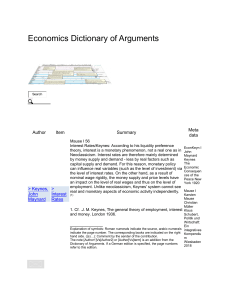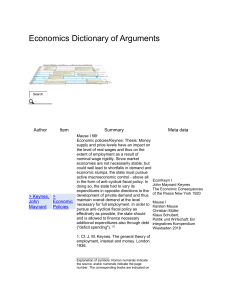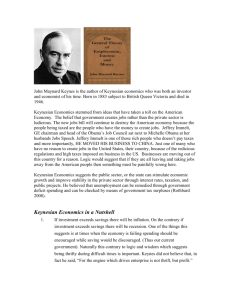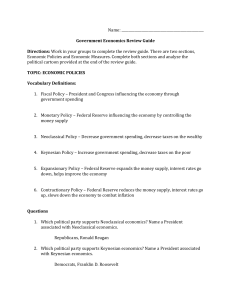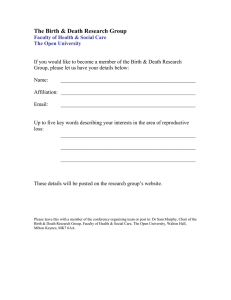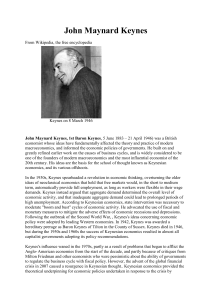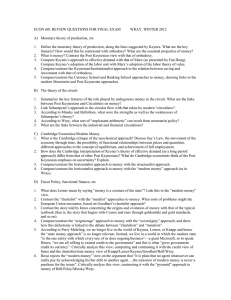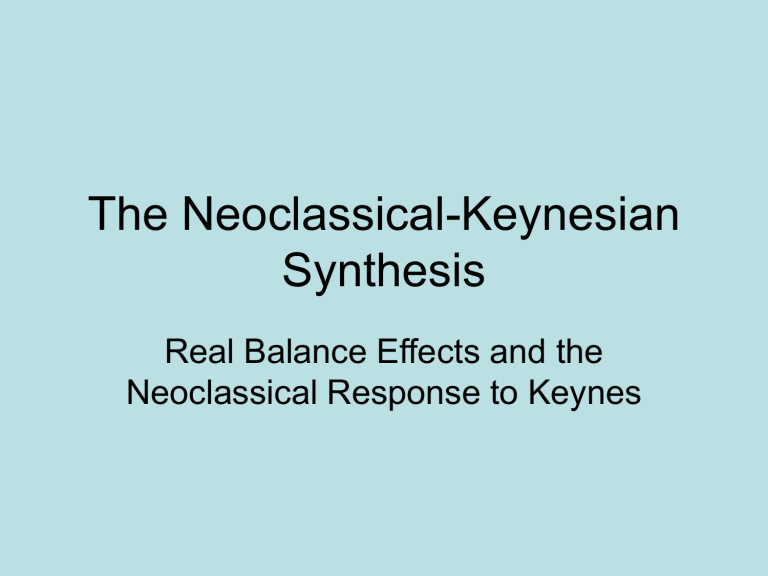
The Neoclassical-Keynesian Synthesis Real Balance Effects and the Neoclassical Response to Keynes The Neoclassical Response to the Keynesian Critique 1. Some neoclassical economists became Keynesians 2. Some tried to ignore Keynes 3. Some misinterpreted Keynes as arguing that sticky wages and prices could cause unemployment in the long run (this result was already in neoclassical economics—if that is all that Keynes was arguing, then Keynes was not making a new contribution). Neoclassical Response to Keynes 4. This next response was the most interesting: it said, “Keynes is making some real contributions and we should recognize that. His theory of the multiplier, his argument that we should conduct aggregate analysis and that money should play a central, determining role, even his liquidity preference theory, are all real contributions and should be incorporated into the analysis.” Response to Keynes • “But,” this response continued, “if Keynes is saying he is refuting neoclassical theory he is going too far.” “Because,” they said, “it can be shown that all of these contributions can be incorporated into the broader neoclassical framework and it can still be demonstrated that the central proposition of neoclassical macro theory still holds.” Central Proposition of Neoclassical Macro • They argued: “It can still be shown that if wages, prices, and interest rates are perfectly flexible that the economy will tend to full employment in the long run.” • The argument will look a little different, it won’t be simply the old neoclassical labor and loanable funds markets story. Grand Neoclassical-Keynesian Synthesis • This argument, which came to be known as the neoclassical synthesis, used the real balance effects arguments to demonstrate their proposition. • The real balance effects has two parts: the direct real balance effect, or Pigou effect, and the indirect real balance effect, or Keynes effect, or interest rate effect. Real Balance Effects • The real balance effect argument begins by noting that in Keynes if there is unemployment, or aggregate supply is greater than aggregate demand, firms will cut back production, income will fall, and employment will fall. • But, they ask, what if instead of cutting output, firms cut prices in response to insufficient demand? And if this occurred throughout the economy, the price level would fall (there would be deflation). Deflation means that the real value of money would rise. Direct Real Balance (or Pigou) Effect AS>AD P ↓ real value of $ ↑ (C + I)↑ mult effects Y↑ Yf When AS>AD, the price level falls, increasing the real value of money. Consumers and investors holding cash would feel richer, and consumption and investment would rise. This would set off multiplier effects, increasing output and income. As long as AS>AD, this would continue, until full employment. Indirect Real Balance (or Keynes or Interest Rate) Effect AS>AD P ↓ real value of $ ↑ amount of $ necessary to satisfy transactions demand for $↓ amount of $ available for speculative demand↑ demand for securities↑ bond prices↑ interest rates↓ (C + I)↑ mult Y↑ Yf Demand for Money in Keynes Keynes asked the question: “Why would anyone hold any of their wealth in the form of cash rather than in higher interestearning or profit-bearing assets?” He gave three reasons in The General Theory: transactions demand for cash, precautionary demand for cash and the speculative demand for cash. Demand for Money Transactions demand – wealth people keep in the form of cash to make normal daily, weekly, and monthly transactions. Precautionary demand – in case of emergencies (flat tire, broken arm, etc.) Speculative demand – in case an unexpected financial opportunity should arise, to earn higher than normal profits. inverse relation between bond prices and interest rates Suppose a bond that sells for $1000 earns $50 per year interest. So the interest rate is 5%. Then suppose the interest rate rises to 10%. The bond is locked in to a return of $50 per year, so the price falls to $500. (think of the alternative of putting $1000 in the bank at 10%, it would earn $100, so no one would buy the bond for $1000 when the return is $50 if the interest rate is 10%.). Real balance effects and neoclassical synthesis • Notice that the RBE incorporate aggregate analysis, money as a central determining variable, the multiplier, and liquidity preference theory all from Keynes. • Yet the central proposition of neoclassical macro still holds—if wages, prices, and interest rates are perfectly flexible, the economy tends to full employment in the long run, no government intervention. Keynesian reply to RBE 1. yes, if price level falls, real value of $ rises, but what about the real value of noncash assets? So, whether you feel richer or poorer when there is deflation depends on whether households and businesses keep their wealth in cash or non-cash assets. Keynesian reply to RBE 2. yes, if price level falls, real value of $ rises, but what about the real value of debt? Debt is denominated in cash, so real value goes up when price level falls. Whether households and businesses feel richer or poorer when there is deflation depends on the importance of debt (consumer debt, corporate debt, and government debt as well). Keynesian reply to RBE 3. Consideration of expectations complicates the RBE stories. If consumers and investors do not know if prices and interest rates will continue to fall, they may not buy (and borrow to buy), but wait and see if they fall more. And if they do not buy (and borrow), then prices and interest rates continue to fall. How high will the real value of debt inflate before they think prices and interest rates have hit rock bottom? Keynesian reply to RBE 4. Lower prices may be good for buyers, but are they good for sellers? It depends. If you are thinking about investing in producing widgets because interest rates are down, and you see the prices of widgets falling, there is a limit to how low prices can go before it is a dis-incentive for you to expand output in that market. Keynesian reply to RBE 5. Indirect real balance effect reintroduces the mechanistic inverse relation between interest rates and investment that Keynes criticized. (this applies only to the indirect real balance effect). Keynesian reply to RBE 6. Historical experience and empirical record a. Great Depression – deflation, but no real balance effects. Interest rates zero, no investment. b. Post WWII experience of industrialized nations. Many periods of unemployment, but virtually no deflation. (slowing of inflation not the same as deflation)
